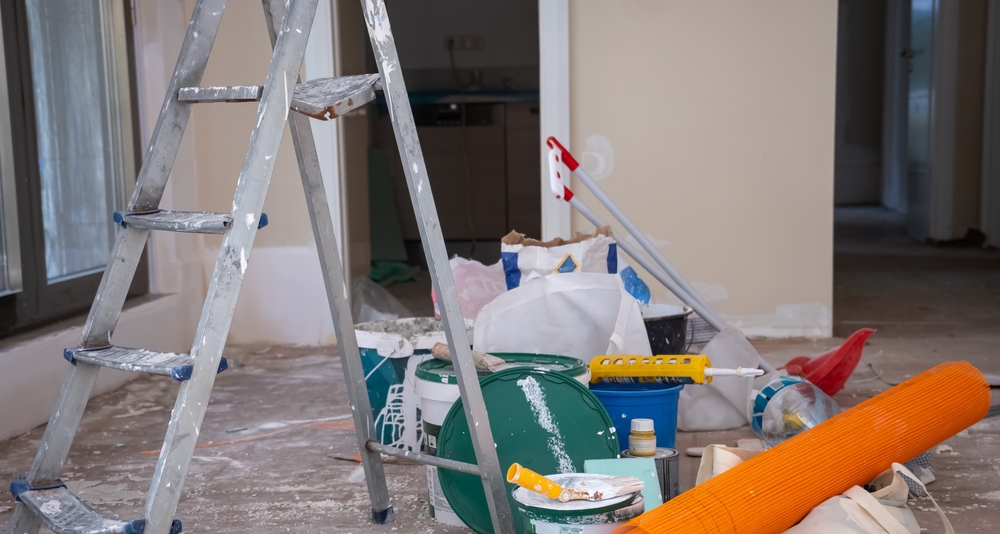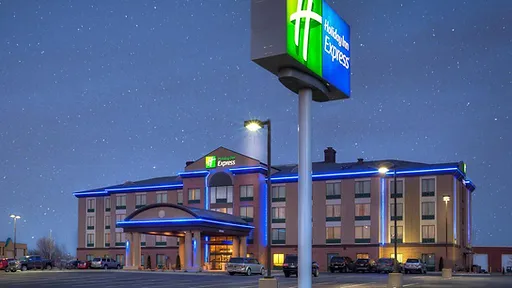Table of Contents
ToggleIt’s common for business owners to hesitate or feel uncertain when deciding to invest in a professional commercial painting project. While it may seem like a purely aesthetic choice, the effects of a fresh coat of paint go far beyond just appearance. The colors and upkeep of a commercial space can significantly impact brand identity, customer perceptions, and even employee productivity.
Colors alone play an integral role in brand recognition. Up to 90% of snap judgments about products are based on color alone. Or do you think Coca-Cola’s bold red color is just a design choice? It’s a psychological trigger for red, which is associated with excitement and energy.
This means the shades we choose in commercial spaces aren’t just about personal preference—they’re about reinforcing brand consistency, building trust, and making a business instantly recognizable. A well-thought-out color scheme strengthens presence, while an outdated or mismatched one can kill or at least reduce the brand’s impact.
First impressions matter; customers will form a quick opinion about a business before interacting with the team. So, beyond colors, it makes sense to consider a freshly painted space as a way to convey professionalism, reliability, and attention to detail. Customers are likelier to engage with businesses that have a clean, polished, and inviting environment (no fading colors or chipped paint).
But it’s not just about customers—what about employees and their performance? The right paint colors can have a bigger impact on motivation and focus than many business owners realize. Certain colors can enhance productivity, reduce stress, and create a workspace that fosters efficiency and engagement.
All these factors reinforce the fact that commercial painting isn’t just a cosmetic upgrade—it’s a strategic decision that directly affects the bottom line.
However, tackling a commercial painting project isn’t as simple as grabbing a roller and a paint bucket. There’s a world of difference between residential and commercial painting, between DIY and hiring a professional and between a well-executed job and one that leads to costly mistakes. Keep reading to make sure you know all the factors that will impact your project’s success.
What is commercial painting, and how does it differ from residential?
Commercial painting involves applying paint and protective coatings to the interiors and exteriors of various business establishments, including offices, retail stores, restaurants, hotels, hospitals, and industrial facilities. Unlike residential painting, which focuses on homes, commercial painting addresses the unique needs of businesses, often requiring larger scales and more complex approaches.
A well-executed paint job enhances a space’s visual appeal, creating an inviting atmosphere that attracts customers and clients.
Consider McDonald’s: their iconic red and yellow color scheme is designed to stimulate appetite and convey happiness, making the space inviting for customers. Now, think about Sears. Remember how their stores started looking outdated, dull, and neglected? That wasn’t just bad luck—that drab, uninspired atmosphere made customers subconsciously associate the brand with decline, and we all know how that ended.
Investing in professional commercial painting, more than just making the space look prettier protects the property, reinforces the brand, and makes a statement before clients even walk through the door. Here’s why it matters:
- First impressions matter (a lot): A building’s exterior is a business’s handshake. A faded, peeling paint job says, “We don’t care,” while a fresh coat says, “We mean business.” Customers, clients, and investors notice this stuff—it influences whether they walk in, keep walking, or take you seriously at all.
- Boost property value: A well-maintained building is a more valuable building. Fresh paint makes a property look newer, cleaner, and worth more, whether it’s for selling, leasing, or just maintaining its appearance for future investments.
- Buildings age, too: Sun, rain, wind, pollution—each property takes a beating. High-quality paint acts like sunscreen for a building, preventing moisture damage, cracks, and general wear and tear that would otherwise cost a lot of money in repairs.
- Happier employees are more productive: Nobody likes working in a dull, outdated office. The right colors can actually impact mood and productivity—blues for focus, yellows for energy, and greens for balance. A fresh, modern space makes employees feel better about showing up daily.
- Reinforce your brand: Your building should be an extension of your brand. Consistent colors and finishes create recognition and trust. A well-thought-out paint job can make your business more inviting and memorable.
- It saves money in the long run: A professional paint job covers protection. The right coatings prevent mold, mildew, and structural damage, reducing expensive maintenance and unexpected repairs.
- Energy efficiency: Yes, paint can do that. The right paint can help with insulation, reflecting heat in the summer and retaining warmth in the winter. That means lower energy bills, which adds up fast for commercial properties.
- Compliance and safety: Fines are not a business’s friend. Regulations around commercial buildings are real, and many areas have strict rules on paint types, especially regarding VOC levels. Professional painters ensure businesses stay compliant so they don’t face unnecessary fines.
It’s not just about your chosen color; it goes far beyond that. A professional commercial painting job— and we will delve deeper into the significance of professionalism— is an investment, a protective measure, and a perception. A quality paint job pays for itself in ways you might not recognize until you see the difference— and until customers and employees notice it, too.
What is the difference between commercial and industrial painting?
While both commercial and residential painting involves applying paint to structures, there are several key differences:
Scope and scale
- Professional commercial painting projects can range from large-scale spaces like office buildings, shopping malls, and industrial complexes to smaller businesses such as restaurants, retail stores, boutique shops, and medical offices. These projects require extensive planning to minimize business disruptions, larger teams to complete the work efficiently, and specialized equipment like scaffolding and sprayers to handle various surfaces and structures. Whether it’s a corporate headquarters maintaining a professional image or a café creating an inviting atmosphere, commercial painting is tailored to the specific operational and branding needs of the business.
- Residential painting projects, on the other hand, typically involve single-family homes or individual units, making them smaller in scale and often more straightforward. They usually require a smaller crew and more standard tools. The focus is primarily on aesthetics and personal preference rather than durability for high-traffic areas (although they do have some) or compliance with business regulations.
Customer-focused designs
- Professional commercial painting projects are designed with customers, clients, and tenants in mind. Businesses need colors that align with brand identity and create a welcoming environment for their target audience. The goal is to enhance customer experience while maintaining a professional and polished look.
- Residential painting projects are entirely homeowner-driven, focusing on personal taste and lifestyle preferences rather than customer engagement. Since homes don’t need to attract foot traffic or reinforce branding, the color selection process is more about individual expression than strategic business positioning.
Materials and equipment
- Professional commercial painting projects use industrial-grade paints and coatings designed for durability and compliance with safety standards. Equipment like aerial lifts and sprayers are commonly used to handle the size and complexity of the projects.
- Residential painting projects generally use standard paints suitable for home environments. The equipment needed is less specialized, often limited to ladders, brushes, and rollers.
Scheduling and flexibility
- Professional commercial painting projects are often scheduled outside of regular business hours, including nights and weekends, to minimize disruption to operations. This requires a high degree of flexibility and coordination.
- Residential painting projects’ scheduling is typically more flexible and often coordinated around the homeowner’s availability, with work usually occurring during daytime hours.
Scheduling and flexibility
- Professional commercial painting projects understand that businesses can’t afford lengthy downtime. Therefore, they use fast-drying paints like latex or low-VOC options to speed up the process and minimize odors. Quick turnarounds are especially important for restaurants, offices, and hotels that must remain operational during or immediately after the project.
- Residential painting projects understand that homeowners have more flexibility with drying times, allowing for oil-based paints or thicker coatings that take longer to cure but provide a richer, more durable finish. Since there’s no rush to reopen for customers, residential painters can focus on detailed application rather than speed.
Safety and compliance
- Professional commercial painting projects must adhere to strict safety regulations, including OSHA standards, especially when working in environments like hospitals or factories. Painters may need specialized training to operate equipment and handle hazardous materials.
- While safety is still a concern in residential painting projects, the regulations are generally less stringent, and the environments pose fewer risks.
Project management
- Professional commercial painting projects often require detailed project management to coordinate multiple teams, manage timelines, and ensure minimal disruption to business activities.
- Residential painting projects typically involve simpler project management, direct communication with the homeowner, and fewer logistical challenges.
Cost considerations
- Professional commercial painting projects generally have higher costs due to the larger scale, specialized materials, and equipment. However, the investment is justified by the enhanced durability and compliance with industry standards.
- The costs of residential painting projects are usually lower, reflecting their smaller scale and less complex requirements.
Understanding these differences is crucial for businesses and homeowners alike. It allows them to make informed decisions and ensure that their painting projects meet their specific needs and expectations.
But knowing the difference is just the first step—when it comes to commercial spaces, the real question is whether it’s worth handling the job in-house or hiring professionals who specialize in large-scale painting projects.
Why hire a commercial painting service?

Hiring a commercial painting service is necessary to give a business a fresh, professional look. Rather than considering it a luxury option, it’s crucial to understand its importance in branding, customer perception, and long-term maintenance.
While business owners try to cut corners by handling the project themselves or delegating it to an in-house team, DIY painting often leads to costly mistakes, headaches, and disruptions that could have been avoided. Just ask any owner who’s lived through a botched DIY project.
Take it from this DIY Regret Hall of Fame: poor paint jobs, shortcuts, and underestimated timelines that caused far more trouble than they’re worth.
One homeowner tried painting their own kitchen cabinets, only to spend two weeks in a torn-up kitchen, realizing later that a pro could’ve finished the job in an hour with better results. At the same time, another skipped priming their wood floors to save time, only to spend a decade repainting and retouching the peeling surface.
The same issues happen in commercial spaces, but the stakes are even higher. A poorly done paint job can make a business look run-down, unprofessional, or even unsafe. And if you think a quick DIY refresh will save money, think again—it’ll likely cost you more in rework, lost business, and even structural damage.
Why hiring a pro is worth it
- It will actually look good
Let’s just skip the “it looked easy on YouTube” trap. Painting seems simple until you’re halfway through, dealing with streaks, uneven coats, and unexpected repairs.
Most DIY disasters start with overconfidence. It’s easy to underestimate the skill and expertise needed for a seamless, long-lasting paint job. A professional commercial painting worker knows how to:
- Properly prep surfaces (cleaning, sanding, patching cracks, priming)
- Choose the right type of paint for durability, finish, and weather resistance
- Apply even, professional-grade coats that don’t streak, bubble or fade prematurely
DIYers often skip these steps, thinking they’ll save time or money. However, they often end up with peeling, cracking, or streaky paint that needs to be redone within months, which costs more in the long run.
- It saves you time (and sanity)
Business owners already have enough on their plate. The last thing you need is to turn painting into a multi-week headache that pulls you (or your employees) away from actual work.
Let’s take another cautionary tale from the BuzzFeed DIY Regret List: A couple thought they could remove and re-tile their entire downstairs floor in a weekend. Two months and thousands of wasted dollars later, they had to hire professionals to fix their mistakes.
Now, picture your business operating in a half-painted space cluttered with drop cloths and perpetually smelling of paint fumes. A professional crew steps in, completes the job quickly and minimizes disruptions so your business can continue to run smoothly.
- No surprises (or disasters)
DIY projects tend to snowball into bigger problems when you’re not a pro. What starts as a simple repaint can turn into:
- Uneven finishes that need redoing
- Unintended damage to surfaces (especially on delicate materials like stucco, brick, or metal)
- Paint fumes linger for weeks due to poor ventilation
- Safety hazards, like improper ladder use, exposure to toxic materials, or even fires (yes, one guy in the BuzzFeed article literally burned down his entire house by removing a wall).
You don’t have to worry about these risks with a commercial painting service. Pros are trained to handle unexpected challenges, use proper equipment, and apply paints safely and efficiently.
- Branding matters
As we mentioned earlier, the appearance of your building directly influences how customers perceive your business. If your storefront, office, or restaurant appears outdated, dingy, or neglected, people notice.
A fresh, professional paint job sends a message:
- You take pride in your business
- You care about customer experience
- Your space is inviting, well-maintained, and trustworthy
Neglecting your building’s appearance can drive customers away before they even walk inside.
- Cost-effective in the long run
DIY or cheap paint jobs often mean cut corners—and cut corners come back to bite you. Here’s why:
- Low-quality paint fades, chips, and peels faster, meaning more frequent repaints
- Skipping proper prep leads to adhesion problems (paint won’t stick, peels off in months)
- Poor application techniques create streaks, bubbles, or uneven finishes that need fixing
Although a professional commercial painting job might cost more upfront, it will save you money in the long run by lasting longer and preventing costly maintenance down the road. A properly done paint job can last 5-10 years or more with minimal upkeep.
- Less business disruption, more efficiency
If your business is open to customers or employees during painting, the last thing you want is a drawn-out mess. Professional painters have the tools and skills to:
- Work quickly and efficiently (including overnight or weekend jobs to minimize downtime)
- Use low-VOC, fast-drying paints that won’t leave lingering fumes
- Follow a structured process to keep everything on schedule
A DIY or poorly planned job means longer disruptions, lost revenue, and a stressful experience.
- Professional work can help with energy bills
Sure, the right paint can help lower energy bills, but only if it’s applied correctly, and that’s where professionals come in.
- The pros know which coatings are best for insulation and temperature control, preventing you from wasting money on the wrong type of paint.
- They properly prep and apply reflective coatings, ensuring they actually do their job instead of peeling or wearing out in a year.
- Professional-grade materials last longer, meaning you get energy-saving benefits for years, not months.
DIYers often pick the wrong product, apply it unevenly, or skip necessary prep steps—resulting in zero savings and a paint job that needs redoing sooner than expected.
- Compliance and safety
Commercial buildings don’t just need to look good; they need to follow regulations. And unless you’ve got a law degree in paint compliance, this is best left to the experts:
- Professionals use paints that meet safety codes, preventing you from accidentally using non-compliant products that could result in a fine.
- They understand fire-resistant coatings, a requirement in many commercial spaces.
- They dispose of hazardous materials properly so you don’t end up violating environmental laws without even realizing it.
Skipping these steps might not seem that important until an inspector comes knocking or a safety issue arises.
Business owners trying to save money with DIY or cheap painters almost always pay more in the long run.
A poorly executed paint job disrupts a business, making it harder to operate. It’s also a risk because low-quality work means repainting sooner than expected, adding extra costs. These mistakes can drive customers away, weaken your brand, or even lead to safety violations.
A professional commercial painting service handles the prep work so the finish lasts, uses the right techniques to get the job done quickly, and creates a polished, professional look that helps your business stand out.
Want to know exactly what to expect from a professional commercial painting project?
Essential tips and steps for a successful commercial painting project
Embarking on a professional commercial painting project involves careful planning and execution to get a result that actually strengthens your brand and makes your space more inviting for customers and employees.
Here’s a comprehensive guide to what goes into a successful commercial painting job.
Choosing the right colors
Color plays a critical role in branding, with studies showing that it can increase brand recognition by up to 80%. The colors used in a commercial space need to align with the company’s values, messaging, and the emotions they want to evoke. Think of:
- Tiffany & Co.’s Blue: Tiffany’s iconic robin’s egg blue is synonymous with luxury, exclusivity, and elegance. Customers emotionally connect it to special occasions, status, and timeless beauty. If Tiffany suddenly switched to a standard black or beige, it would lose the emotional and brand power that has made it instantly recognizable worldwide.
- Caterpillar’s Yellow & Black: Caterpillar (CAT) uses a bold yellow with black to symbolize strength, durability, and industrial power. The high-visibility yellow isn’t just a branding choice; it also reflects the functionality of construction equipment, making machinery stand out on worksites. If CAT switched to a soft pastel, it wouldn’t evoke the same confidence in the heavy-duty industry.
The colors you choose for your business should reflect the experience you want your customers to have. A high-end jewelry store will likely choose sophisticated dark tones or rich blues, while a fitness studio might choose energetic reds or yellows to inspire movement and motivation.
In addition, color psychology says that different colors impact people’s moods, emotions, and even decision-making, which is why it’s a a key factor in commercial painting.
- Blue: Promotes calmness, trust, and focus, making it ideal for offices, banks, and medical facilities.
- Green: Associated with balance, health, and relaxation, making it a great choice for wellness centers and organic brands.
- Red: Creates urgency and excitement, which is why it’s common in fast food restaurants and retail sales signage.
- Yellow: Stimulates happiness and creativity but can be overwhelming if overused. It’s commonly seen in entertainment and retail spaces.
- Black: Conveys luxury and sophistication, making it a strong choice for high-end brands and designer boutiques.
Before choosing colors, businesses should consider what feelings they want their customers and employees to experience in their spaces. Professional commercial painting companies know how to help them choose the right one.
Preparing the space for painting
Businesses should prepare their space properly before applying the previously chosen colors so the process goes smoothly without unnecessary delays, damage, or disruptions.
The first step is clearing out the space. Furniture, equipment, and decor need to be moved or covered to avoid paint splatters and dust damage. In offices, this means desks, chairs, and electronics. In retail stores or restaurants, it’s shelving, displays, and anything that could get in the way of a clean, even paint job.
For businesses that can’t afford to move everything, temporary partitions and protective coverings help keep work areas clean and functional while painting is in progress. Professional painters know how to section off spaces to minimize downtime, ensuring operations can continue with minimal disruption. This leads to our next step.
Surface repairs and proper preparation
A paint job is only as good as the surface underneath it. Slapping fresh paint over cracks, peeling layers, or rough patches will not solve the problem; it will just hide the problem for a while until it inevitably resurfaces.
Before any painting starts, professional painters inspect and repair surfaces to ensure a flawless finish. This includes:
- Patching cracks and dents to create a smooth, even surface.
- Sanding rough areas so the paint adheres properly.
- Fixing peeling or chipping paint so the new coat doesn’t flake off prematurely.
- Applying primer helps the paint stick better and last longer, preventing stains, discoloration, and uneven finishes.
Skipping these steps leads to a paint job that looks bad, wears out quickly, and needs redoing much sooner than expected. A professional ensures the surface is prepped correctly so the paint job lasts for years, not months.
Contact us here if you would like to find the best painting contractor for your residential or commercial painting needs.
Exterior painting cost vs. interior: How to calculate them

There are two aspects to consider when tackling a commercial painting job: interior and exterior. While interior painting focuses on aesthetics and creating the right atmosphere, exterior painting is about durability, protection, and curb appeal.
A professional commercial painting job, of course, involves thorough prep, high-quality materials, and skilled labor to ensure a long-lasting finish that can withstand weather, wear, and time.
Regarding exterior and interior painting costs, prices can vary and depend on several factors, including the size of the building, the materials being painted, the level of prep work required, and even geographic location.
So, how much does a commercial painting service actually cost—inside and out? Let’s break it down.
Factors that affect commercial painting costs
- Size of the Building (per square foot pricing)
The most common pricing model for commercial painting is per square foot or per square meter (m²). Painters typically charge:
- Exterior painting cost per m²: $10 to $50, depending on surface type and prep work
- Interior painting cost per m²: $10 to $40, depending on complexity and paint finish
For a medium-sized commercial building (10,000 sq. ft.), total costs can range from $15,000 to $75,000 depending on materials, labor, and location.
- Surface type & material
Different materials require different paints and preparation, impacting both exterior and interior costs.
Exterior Painting Cost by Surface Type:
- Wood siding: $1 to $4 per sq. ft.
- Stucco: $1 to $5.50 per sq. ft.
- Vinyl siding: $1 to $3 per sq. ft.
- Brick: $1.50 to $4.50 per sq. ft.
- Metal/Aluminum: $1 to $4 per sq. ft.
- Concrete: $1 to $3.50 per sq. ft.
Interior Painting Cost by Surface Type:
- Drywall: $1.50 to $3.50 per sq. ft.
- Plaster walls: $2 to $4 per sq. ft.
- Exposed brick/concrete: Requires specialty coatings, averaging $3 to $7 per sq. ft.
- Prep work & repairs
Surface preparation is often one of the most expensive parts of a professional commercial painting job. This includes:
- Power washing to remove dirt, mold, and loose paint
- Sanding and patching cracks or damage
- Priming surfaces for proper paint adhesion
On average, prep work alone can cost between $0.50 and $2.50 per square foot, depending on the level of surface repairs needed. If you skip this step, you can expect to repaint sooner than you’d like.
- Paint type & quality
Not all paint is created equal. Commercial-grade, weather-resistant paints cost more but last longer, saving money over time. Higher-end paints often include UV protection, mold resistance, and coatings that minimize wear. Some commercial projects also require low-VOC (volatile organic compound) paints for environmental and health compliance, which can increase pricing.
- Height & accesibility
Expect higher costs if your commercial property is multi-story. Painters charge extra for scaffolding, lifts, or other specialized equipment needed to reach tall or difficult areas. The more complex the job, the higher the cost.
Exterior painting cost calculator
To get a rough estimate for your professional commercial painting job, use this simple Exterior Painting Cost Calculator formula:
- Total Cost = (Square Footage × Cost per Square Foot) + Prep Work + Labor + Equipment
For example, if you have a 5,000 sq. ft. building with stucco siding, using mid-range paint, and moderate prep work, the cost might look like this:
- (5,000 sq. ft. × $3.50) + ($1 per sq. ft. for prep) + ($1.50 per sq. ft. for labor) = $30,000 total
So, for businesses wondering, “How much do painters charge per m²?” Rates typically range from $10 to $50 per m² for exterior painting and $10 to $40 per m² for interior painting, depending on surface type, prep work, and location.
However, remember that every project is unique, and the best way to get an accurate price is to request quotes from professional painters.
How to choose the right professional commercial painting service

So, you’ve decided to move forward with a professional commercial painting project. You know the benefits, you understand the costs—but now comes one of the most important steps: choosing the right painting contractor. A commercial paint job is an investment in your business’s image, and the last thing you want is to pay for sloppy work, unexpected costs, or a rushed job that needs a redo in a year. Here’s what to look for.
Qualities of a true professional
A commercial painting service should have more than just a few good Yelp reviews. You want a team that understands the complexities of large-scale projects, works efficiently, and delivers long-lasting results.
- Years of experience & certifications: A well-established painting company with years of experience in commercial projects is always a safer bet than a general contractor who dabbles in painting. Look for certifications, manufacturer endorsements (e.g., Sherwin-Williams or Benjamin Moore partnerships), and OSHA safety training—especially if your project involves heights, hazardous materials, or industrial spaces.
- Industry reputation & client feedback: The best painters have a track record of satisfied clients. Check Google Reviews or industry forums for feedback from past customers. A reputable company won’t just tell you they’re great—they’ll have a portfolio and references to prove it.
- Reliability & communication: Do they answer emails and calls promptly? Are they clear and transparent about their process? A contractor who’s slow to communicate before you hire them is unlikely to be any better once they’re on the job.
Reviewing portfolios & customer testimonials
A professional commercial painting contractor should have before-and-after photos, case studies, or even video testimonials to showcase their work.
- Look for similar projects: If you’re painting a restaurant, check if they’ve worked on other dining spaces. If it’s a large office building, look for multi-floor projects in their portfolio. Koehn, for example, has
- Check for consistency: Do the finishes in their portfolio look smooth and even? Are the lines crisp? Are the colors vibrant and true to the brand?
- Read between the lines in reviews. A company with all five-star reviews but no details might be filtering out bad ones. Look for genuine customer experiences—people who mention timeliness, professionalism, and communication.
Questions to ask during an on-site walkthrough
A good contractor won’t just give you a quote over the phone—they’ll want to see the space in person before estimating costs. This is your chance to gauge their expertise.
- How do you determine the cost estimate? A professional should break down labor, materials, prep work, and the timeline, not just give a flat number.
- What type of prep work will be required? If they don’t mention patching cracks, sanding, or priming, that’s a red flag. Proper prep is what separates a high-quality, long-lasting job from one that peels in a year.
- How do you handle business disruptions? They should have a clear plan for working around business hours, avoiding mess, and minimizing downtime.
- What type of paint and finish do you recommend? A pro will recommend paints suited for high-traffic areas, durability, and brand consistency—not just the cheapest option.
If they can’t confidently answer these questions, they’re either inexperienced or cutting corners.
Questions to ask during an on-site walkthrough
Too many business owners overlook this part until something goes wrong. You’re trusting this contractor with your property, your time, and your money. Protect yourself.
- Confirm they’re licensed & insured: A commercial painter should have liability insurance and worker’s compensation coverage to protect against on-the-job accidents. Without it, you could be on the hook for damages.
- Get everything in writing: A professional will provide a detailed contract outlining:
- Scope of work (what’s being painted, materials, and prep work)
- Total cost and payment terms
- Timeline and project completion date
- Warranty details (a quality contractor will offer one!)
- Check for hidden costs. Ask upfront if there will be extra fees for additional coats, material changes, or unexpected repairs. A reputable contractor will be upfront about potential additional costs before starting the job.
Inspiration time: Commercial painting projects done right
A well-executed commercial painting project transforms the space. The right colors and finishes can turn a dull, outdated environment into an inviting and brand-aligned space that enhances customer experience and employee satisfaction. Some standout projects showcase how expert commercial painting can elevate different industries.
A fresh coat of paint can revitalize a business, whether it’s a restaurant, retail store, or office space. Take Abuelo’s West and Cheddar’s Scratch Kitchen, where outdated interiors were replaced with warm, inviting tones that match their branding and create a welcoming atmosphere for diners.

Abuelo’s West after Koehn’s professional commercial painting project
In the hospitality sector, K5 Painting’s work at Holiday Inn and Aloft Hotel shows how a modern, cohesive color scheme can make a space feel more luxurious and comfortable for guests.

Holiday Inn’s after Koehn’s professional commercial painting project
From aerospace hangars to restaurants, sports arenas to hospitals, the right commercial painting service can make all the difference. These transformations prove that with expert planning, the right color choices, and professional execution, any space can become more functional, appealing, and aligned with business goals.
FAQs: We got you covered
What is the scope of a painting project?
A commercial painting project includes surface preparation, priming, painting, and finishing, as well as repairs such as patching cracks, sanding, and sealing. The scope varies depending on the building’s size, materials, and customization needs.
What does a commercial painter do?
A commercial painter specializes in large-scale painting projects, including offices, warehouses, restaurants, and industrial facilities. They handle prep work, surface treatments, coatings, and safety compliance to ensure durability and longevity.
How to prepare for professional painters?
Clear the area by moving furniture, covering equipment, and ensuring surfaces are clean. To minimize disruptions, discuss scheduling with the painters and inform employees or tenants about the project timeline.
How long does a commercial painting project take?
Project duration depends on size, surface prep, and drying times, but most commercial jobs take a few days to several weeks. Large buildings or highly detailed projects may require phased painting to maintain operations.
Will I need to shut down my business during painting?
Not necessarily. Many commercial painters work around business hours, scheduling painting overnight, on weekends, or in sections to reduce downtime. In high-traffic areas, temporary barriers can help minimize disruptions.
What’s the best type of paint for high-traffic areas?
Semi-gloss or satin finishes are best for high-traffic areas. They are durable, easy to clean, and resistant to scuffs and stains. Epoxy coatings work well for warehouses and industrial spaces that require extra protection.
How often should I repaint my commercial space?
Most commercial spaces need repainting every 5-7 years, though high-traffic areas like restaurants, offices, and hotels may require touch-ups sooner. Depending on weather exposure, exterior surfaces may need fresh paint every 3-5 years.
Can commercial painters match specific brand colors?
Yes! Professional painters use color-matching technology to ensure your walls are the exact shade of your brand. They work with major paint brands to achieve precise matches for logos, accent walls, and branding consistency.
A worthwhile investment
A professional commercial painting project is a strategic investment in your business’s image, longevity, and success. The right paint job reinforces brand identity, attracts customers, boosts employee productivity, and protects your property from wear and tear.
While cutting corners with DIY or low-quality work often leads to higher costs, faster deterioration, and a poor first impression, hiring experienced commercial painters ensures durability, efficiency, and a polished finish that stands the test of time.
When done right, professional painting pays for itself in reputation, customer trust, and long-term savings. Your business deserves that advantage.
Discover the Koehn Painting difference – contact us today for a free estimate and step into a vibrant, freshly painted home!





